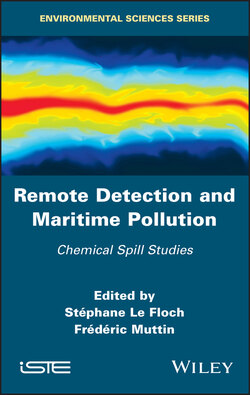Remote Detection and Maritime Pollution

Реклама. ООО «ЛитРес», ИНН: 7719571260.
Оглавление
Группа авторов. Remote Detection and Maritime Pollution
Table of Contents
List of Illustrations
List of Tables
Guide
Pages
Remote Detection and Maritime Pollution
Forewords
1. POLLUPROOF Project. 1.1. Introduction
1.2. POLLUPROOF project. 1.2.1.Objectives
1.2.2.Hazardous and noxious substances
1.3. Experimental approach
1.3.1.Calibration of optical sensors
1.3.1.1. Vertical configuration
1.3.1.2. Horizontal configuration
1.3.1.3. Tank
1.3.2.Evaluation of radar, optical and hyperspectral sensors at sea. 1.3.2.1. General presentation of the experiment
1.3.2.2. Experimental releases
1.4. Conclusion
1.5. References
2. Multifrequency Radar Imagery and Characterization of Hazardous and Noxious Substances at Sea. 2.1. Introduction
2.2. Experimentation at sea. 2.2.1.Radar imagery
2.2.2.Chemical products
2.2.3.Planning of measurements
2.3. Methodology. 2.3.1.Scattering from ocean surface
2.3.2.Detection and relative quantification
2.3.3.Oil/water mixing index
2.4. Results and discussion. 2.4.1.Observation of hazardous and noxious substances at sea
2.4.2.Detection and quantification of impact on the ocean surface
2.4.3.Characterization
2.5. Conclusion
2.6. Acknowledgments
2.7. References
3. Remote Sensing of HNS using Longwave Infrared Hyperspectral Imaging. 3.1. Introduction
3.2. LWIR hyperspectral remote sensing capability
3.2.1.Basin measurements at CEDRE
3.2.2.Sea measurements
3.3. Detection and identification of HNS using LWIR hyperspectral sensing
3.3.1.Detection phenomenology
3.3.2.Detection algorithm
3.3.3.Basin measurements at CEDRE
3.3.4.Sea measurements
3.4. Conclusion
3.5. References
4. Customs Expertise in Remote Sensing. 4.1. Introduction
4.2. The aircraft
4.3. The equipment
4.4. Airborne remote sensing processing
4.5. Side-looking airborne radar (SLAR) processing
4.6. Infrared and ultraviolet line scanner
4.7. Standard detection and investigation
4.8. The future, a new multi-mission aircraft
5. Remote Sensing as Evidence in Court. 5.1. Introduction
5.2. Legal framework of the offence and the evidence. 5.2.1.What the texts say
5.2.2.What legal precedents have been set?
5.3. Remote sensing: questions and advances. 5.3.1.Does the verdict of theTraquaircase exclude recourse to remote sensing?
5.3.2.What answers and advances have been observed?
5.4. Conclusion
5.5. References
6. Long-Term Surveillance and Monitoring of Natural Events in Coastal Waters. 6.1. Introduction
6.2. Satellite products for long-term surveillance
6.3. Some specific events of natural origin in coastal waters
6.4. Conclusion
6.5. References
7. VIGISAT Ground Receiving Station and EMSA CleanSeaNet Services. 7.1. Introduction
7.2. VIGISAT ground receiving station and detection of pollution in near-real time
7.3. Polluter identification with AIS data flows and drift modeling
7.4. References
8. System-to-system Interface Between the EMSA CleanSeaNet Service and OSERIT. 8.1. Introduction
8.2. The EMSA CleanSeaNet service
8.3. OSERIT
8.3.1.The OSERIT Oil Spill Model
8.3.2.OSERIT visualization tool
8.3.3.OSERIT domain
8.3.4.OSERIT met-ocean forcing
8.3.5.OSERIT oil database
8.4. A system-to-system interface between CleanSeaNet and OSERIT
8.4.1.Scenario 1: automatically triggered forecast
8.4.2.Scenario 2: automatically triggered backtrack
8.4.3.Scenario 3: manually triggered forecast
8.4.4.Scenario 4: manually triggered backtrack
8.5. TheFlinterstarincident. 8.5.1.The incident
8.5.2.Monitoring and surveillance of the oil and its fate/behavior
8.6. Conclusion
8.7. Acknowledgments
8.8. References
9. Optimizing the Use of Aerial Surveillance Assets in Oil Spill Response Operations. 9.1. Introduction
9.2. Assumptions and working hypotheses
9.3. Experimental protocol: testing the primary hypothesis
9.3.1.Technical specifications
9.3.2.Operational requirements
9.3.3.Choice of SUAS
9.3.4.Systematic testing of assumptions
9.3.4.1. Evaluating core assumption 1
9.3.4.2. Evaluating core assumption 2
9.3.4.3. Preliminary findings
9.4. Experimental protocol: underlying assumptions and testing of secondary hypothesis
9.5. The case for using SUAS as a force multiplier in spill response coordination
9.6. Appendix 1
9.7. Appendix 2
9.8. References
10. Potential of Imaging UAVs for Coastal Monitoring. 10.1. Introduction
10.2. Constraints on the survey
10.3. Examples of UAV platforms
10.4. Survey protocol
10.5. Data processing
10.6. Examples of applications
10.7. Conclusion
10.8. References
11. Use of Remote Sensing Techniques to Survey, Detect and Interpret Hydrocarbon Seeps and Spills for Exploration and Environment. 11.1. Introduction
11.2. Methodology
11.3. Offshore facilities monitoring/mining field
11.4. Emergency
11.5. Perspectives
11.6. Conclusion
11.7. References
12. Natural Escapes of Oil in Sedimentary Basins: Space-borne Recognition and Pairing with Seafloor and Sub-seafloor Features. 12.1. Introduction
12.2. Datasets and methods. 12.2.1.Data. 12.2.1.1. Space-borne tools to detect seeping hydrocarbons
12.2.1.2. Assessment of current velocity across the water column
12.2.1.3. Imaging sedimentary series using petroleum exploration data
12.2.2.Methods
12.3. Results. 12.3.1.Oil slick mapping
12.3.2.Oil migration pathways and horizontal deflection
12.4. Conclusion
12.5. References
Conclusion. Principal Conclusions of Debates: Synthesis and Perspectives. C.1. Challenges for innovation
C.2. Preliminary juridical aspects
C.3. Interference of physical factors on sea
C.4. Drone competitiveness
C.5. Pollutant identification
C.6. Sensors
C.7. References
List of Authors
Index. A, B, C
D, E, F
G, H, I
J, K, L
M, N, O
P, R
S, T
U, V, W, X
WILEY END USER LICENSE AGREEMENT
Отрывок из книги
Chemical Spill Studies
.....
HNS releases were performed from the salvage, rescue and oil spill response vessel Ailette of the French Navy under the direction of CEPPOL (Centre of Practical Expertise in Pollution Response) and CEDRE. Each chemical product was contained in a one cubic-meter tank, in HDPE (High Density PolyEthylene) for non-aggressive HNS (rapeseed oil, FAME and methanol) and in metal for reactive or corrosive HNS (xylene, heptane and toluene). Each tank was inserted in a metallic structure equipped with two 220 L floaters to ensure the floatability of the system and a lifting strap to manipulate the tanks with the onboard crane (Figure 1.2). The release of the HNS was performed from a dinghy by pulling a rope that activates the opening of the tank. Due to the difference in density between seawater and HNS, the chemicals spread at the sea surface.
In order to follow the drifts of the HNS slicks, two drifting buoys were implemented. Their GPS positions were transmitted by satellite every 15 minutes.
.....